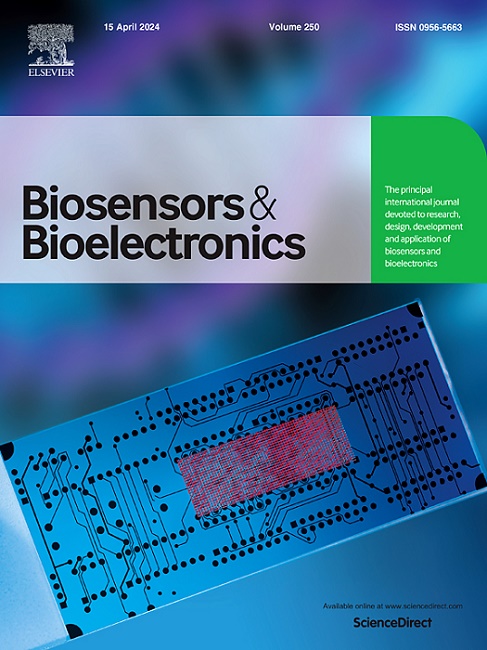缺陷工程调制的鲁棒nCuO增强光电化学生物传感器检测miRNA-21。
IF 10.5
1区 生物学
Q1 BIOPHYSICS
引用次数: 0
摘要
传统的p型CuO (pCuO)具有可调的带隙和p型电导率,在光电化学生物传感器中得到了广泛的应用。然而,由于其导电性弱,导致其电化学信号不理想,限制了其在原位硫化反应中的应用。我们首次通过简单的化学还原合成了具有丰富氧空位的n型CuO (nCuO),并将其作为高效光活性材料应用。由于氧空位促进了载流子分离,nCuO表现出比pCuO更好的光电化学性能。引入miRNA-21后生成H₂S, H₂S与Cu(II)反应,在电极上形成nCuO-pCuS异质结。令人鼓舞的是,由于nCuO- pcus异质结的内置电场可以促进有效的载流子分离,因此在硫化反应后,nCuO的电流增加比pCuO高2.3倍。在最佳条件下,该生物传感器具有良好的分析性能,线性范围宽(0.004-400 pM),检测限为1.8 fM。氧缺陷工程与靶触发硫化的结合为设计高性能光电化学生物传感器提供了新的思路。本文章由计算机程序翻译,如有差异,请以英文原文为准。
Robust nCuO modulated by defect engineering enhanced photoelectrochemical biosensor for the detection of miRNA-21
Traditional p-type CuO (pCuO), valued for its tunable band gap and p-type conductivity, has been widely used in photoelectrochemical biosensors. However, its weak conductivity leads to unsatisfied photoelectrochemical signals and limits its use in in situ vulcanization reactions. We synthesized n-type CuO (nCuO) with abundant oxygen vacancies through a simple chemical reduction for the first time, which was applied as efficient photoactive material. The resulting nCuO exhibits superior photoelectrochemical performance than pCuO, thanks to enhanced carrier separation facilitated by the oxygen vacancies. Upon miRNA-21 introduction, H₂S was generated, which can react with Cu(II) to form nCuO-pCuS heterojunction on the electrode. Inspiringly, the current increase of nCuO is 2.3 times higher than the pCuO after vulcanization reaction due to the built-in electric field of the nCuO-pCuS heterojunction can promote efficient carrier separation. Under optimal conditions, the biosensor offers excellent analytical performance, with a wide linear range (0.004–400 pM) and a detection limit of 1.8 fM. The integration of oxygen defect engineering and target-triggered vulcanization presents a new strategy for designing high-performance photoelectrochemical biosensors.
求助全文
通过发布文献求助,成功后即可免费获取论文全文。
去求助
来源期刊

Biosensors and Bioelectronics
工程技术-电化学
CiteScore
20.80
自引率
7.10%
发文量
1006
审稿时长
29 days
期刊介绍:
Biosensors & Bioelectronics, along with its open access companion journal Biosensors & Bioelectronics: X, is the leading international publication in the field of biosensors and bioelectronics. It covers research, design, development, and application of biosensors, which are analytical devices incorporating biological materials with physicochemical transducers. These devices, including sensors, DNA chips, electronic noses, and lab-on-a-chip, produce digital signals proportional to specific analytes. Examples include immunosensors and enzyme-based biosensors, applied in various fields such as medicine, environmental monitoring, and food industry. The journal also focuses on molecular and supramolecular structures for enhancing device performance.
 求助内容:
求助内容: 应助结果提醒方式:
应助结果提醒方式:


